러시아 철도발전 전략의 현황과 한계점
Current Status and Limitations of Russia's Railway Development Strategy: Historical Improvement and New Prospects
- 경북대학교 러시아-유라시아 연구소
- 러시아유라시아연구
- 제8호
-
2022.10153 - 190 (38 pages)
- 54

21세기를 맞이한 러시아는 푸틴 대통령을 동시에 맞이했다. 푸틴의 등장으로 러시아는 2000년대 이후 급속한 경제적 발전을 이룬다. 국제유가의 상승, 루블화의 강세 등 경제적 발전은 러시아 내부적 체재개선에 영향을 가한다. 이 과정에서 러시아는 철도발전전략을 발표하며 전 러시아의 균형을 갖춘 경제발전, 에너지 강국, 사회적 인프라 구축을 통해 러시아 국민의 삶을 개선한다는 것을 국가발전의 핵심 목표로 정한다. 특히 자원지대와 북극권을 중심으로 한 항로 등의 개발에 따른 중요 목표로 시베리아횡단철도(TSR), 바이칼-아무르철도(BAM), 북극권 철도교통 인프라 구축 과제가 설정되어 있다. 따라서 본 고에서는 러시아의 철도발전 전략의 종합적 추진 배경과 현황 및 한계점을 살펴본다는 것에 목적을 둔다.
In the 21st century, Russia welcomed President Putin at the same time. With the advent of Putin, Russia has achieved rapid economic development since the 2000s. Economic development, such as a rise in international oil prices and a strong ruble, has an impact on improving the internal system of Russia. In this process, Russia announces its railway development strategy and sets the core goal of national development to improve the lives of Russian people through balanced economic development, an energy powerhouse, and the establishment of social infrastructure. In particular, the Trans-Siberian Railway (TSR), the Baikal-Amur Railway (BAM), and the Arctic Circle railway transportation infrastructure construction tasks are set as important goals for the development of resource zones and routes centered on the Arctic Circle. Therefore, the purpose of this paper is to examine the background, current status, and limitations of Russia's comprehensive railroad development strategy.
Ⅰ. 들어가며
Ⅱ. 러시아 철도 및 시베리아 횡단철도 개황
Ⅲ. 러시아 철도, TSR 개발 및 투자정책
Ⅳ. 나가며
참고문헌
(0)
(0)